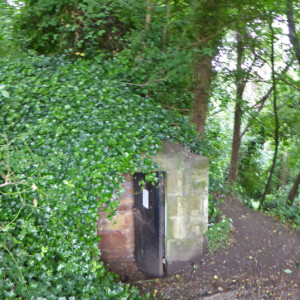A few weeks ago this footpath was lined with stitchwort and bluebells and the sound of bird song filled the air. Today there were only a few birds singing with the calls of buzzards and the sound of the very strong wind blowing in the trees but it was pleasant to walk through the ancient woods and see hardly anyone.
Extra
But I did feel that it would have been good to have seen some people around as I tentatively walked into the dark ice house on my own but I was too scared to venture far. I have never seen the door open except when we were once shown inside by the Park Ranger. He had a torch and told us then about the ice house which lies on the steep slope with the river running below.
Until refrigeration many large estate houses had an icehouse where ice was stored and used for drinks and preservation of food. They were subterranean and would have layers of straw and ice which would be packed tightly together and sometimes the ice would take over a year to thaw out. Ice would be taken out of rivers or ponds or lakes but would not be suitable for adding to drinks but would be perfectly adequate for storing food.
With improved shipping and the advent of railways in the 1800s vast amounts of ice were imported from Norway, Greenland and North America and used partly for the fishing trade but much of it was used by wealthy landowners for stocking their icehouses. As it was pure lake or iceberg ice it was very clean and hygienic so could be used in food and drink. A sign on the door calls it “hard ice” and this ice house at Dalkeith was used until the 1920s. I can’t remember too much about the interior but recall a deep pit with hooks lining the walls from which had hung carcases and of learning that a woman would stay almost permanently just inside the door to protect the meat etc. She must have been very hardy as it would have been an awful job especially in cold weather.
In 1661 Edmund Waller described the new icehouse of Charles II in his poem;
ON ST JAMES’S PARK (As lately improved by His Majesty)
Yonder the harvest of cold months laid up,
Gives a fresh coolness to the royal cup,
There ice, like crystal, firm and never lost,
Tempers hot July with December’s frost;
Winter’s dark prison, whence he cannot fly,
Tho’ the warm spring, his enemy draws nigh:
Strange! That extremes should thus preserve the snow,
High on the Alpes or in deep caves below.

Comments
Sign in or get an account to comment.


